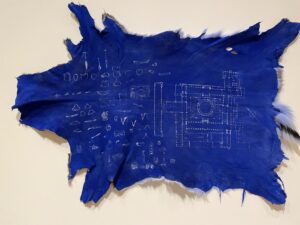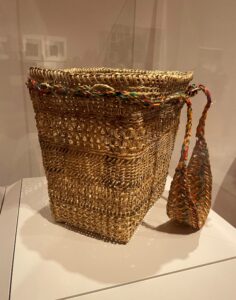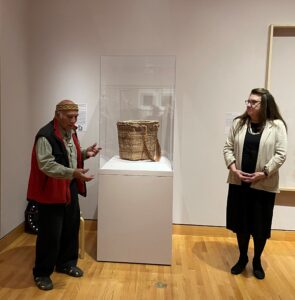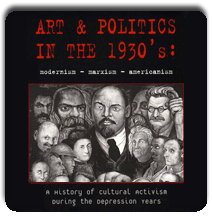Outside the first gallery is this work by Nicholas Galanin, Architecture of return, escape (The British Museum), 2022, an appropriate commentary on removing stolen Native artifacts from the British Museum. Nicholas Galanin is one of the three consulting artists for the project, he will be installing another work in the Spring.
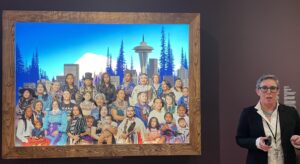
Juan P. Córdova, elementary school teacher at New York City Public Schools
Fulgencio Lazo, artist and co-founder of Studio Lazo
Jared Mills, librarian at Seattle Public Library
Chieko Phillips, cultural administrator
Jake Prendez, owner and co-director of Nepantla Cultural Arts Gallery
Delbert Richardson, ethnomuseumologist
Juliet Sperling, Assistant Professor of Art History, Kollar Endowed Chair in American Art, School of Art + Art History + Design, University of Washington
Asia Tail, Cherokee artist, curator, and co-founder of yəhaw̓ Indigenous Creatives Collective
Mayumi Tsutakawa, writer with focus on Asian American history
Ken Workman, Duwamish Tribal Member and descendant of Chief Seattle
Theresa Papanikolas, Curator of American Art, seen above, and Barbara Brotherton, Curator of Native American Art began to “interrogate and re-contextualize the collection” with the help of 11 community advisors and three artists in the summer of 2021. Certainly, the death of George Floyd, and the protests that followed sparked elite predominantly white institutions across the country to rethink their own unacknowledged racism.
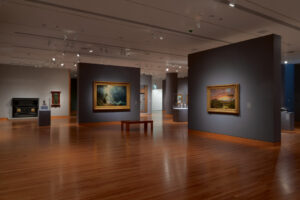
309 and 310 galleries before the 2022 American Art reinstallation.
Consequently, the American art galleries formerly dark and dreary and filled with art by predominantly white artists, have been entirely transformed.
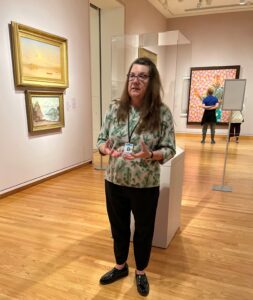
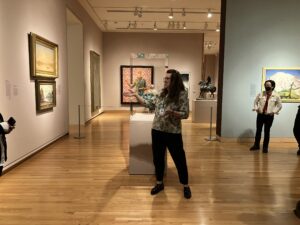
Barbara Brotherton, retiring curator of Native American Art declared that the museum is following a “dramatically different approach, bringing the historical American art collection into conversation with Native, Asian American, African American, Latinx, and contemporary art. This new interpretive framework brings forward historically excluded narratives and artistic forms. Instead of seeing these communities as parallel to the so-called mainstream history, the museum now is looking at intersections. “
No longer organized chronologically, “The Stories We Carry,” features five themes some with two parts: Storied Places,
Transnational/ Trade and Expanding Markets
Transnational/The Internationalism of Objects
Reimagining Regionalism
Ancestors plus Descendants/ Faces of America
Ancestors plus Descendants/Memory Keepers.

Wendy Red Star. “Áakiiwilaxpaake (People of the Earth),” 2022. Seattle Art Museum Commission Archival ink jet prints, dibond, LED lights, electrical components, wood, milk plexiglass, 84 x 62 x 12 in.
At the entrance the delightful Wendy Red Star, one of the lead artists, confronts us with a large lightbox: Áakiiwilaxpaake (People of The Earth). Red Star humorously and seriously speaks of how excluded she felt from the American art galleries by the boring American art genres, portraiture, and landscape.
Portraits of 70 native women, youth and even babies stand in front of the Northwest icons Mt Rainier and the Space Needle. Contemporary Native people are front and center in the present and future, rather than their usual position in the past as a prelude to white America.
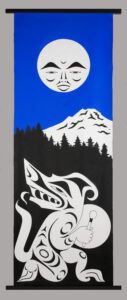
Shaun Peterson (Tulalip/Puyallup, Qwalsius)’s Song for the Moon (2022) presents the Puyallup creation myth in a banner like painting. The label declares: “Native philosophies offer different ways of knowing the land, including the belief that all animate and inanimate beings are alive and indivisible from the land. Nature and its many features are thought to be sacred, not scenic.”
Next to it is Sanford Robinson Gifford’s Mount Rainier, Bay of Tacoma – Puget Sound (1875) with tiny figures dwarfed by the landscape and its golden light. These paintings, as the label comments “cast the region’s original communities as characters in the myth of the American wilderness: wild, remote, and poised to be taken over. “
The next section is Transnational
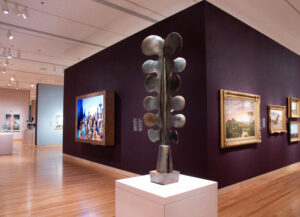
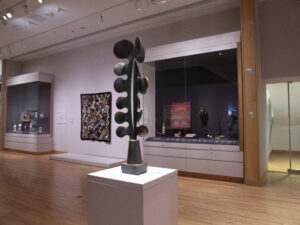
2
It features the sculpture of George Tsutakawa as a connection, in a work inspired by kelp called Mo (Seaweed), 1977. It is based on the seaweed that we see just beneath the surface of the sea. Near it is a short video with an interview with Meg Chadsey, kelp specialist and Gerard Tsutakawa the artist’s son who assisted in the execution of many of the works and is an artist as well.
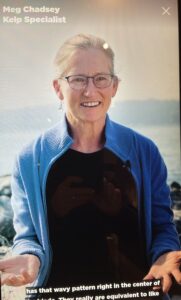
Transnational Trade and Expanding Markets native artists responding to colonizers artistic conventions. This exciting idea moves beyond the tired and condescding concept of “deriviative” to the idea of cross fertilization. In this section we see the eminent Charles Edenshaw’s argillite totem among other works. Only Haida artists can work in argillite, but Edenshaw was brilliant at adapting to Victorian conventions in his work ( not necessarily visible here). He was commissioned at a time when Native cultures were being suppressed, to create a totem for the Museum of Natural History in New York City.
Below is a bottle covered with traditional cedar basketry techniques and a model canoe. Canoes of course are embedded in Native Culture, but this model would have been for sale.
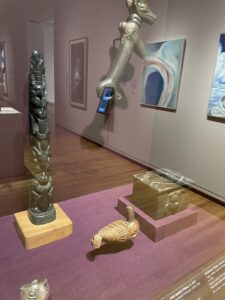
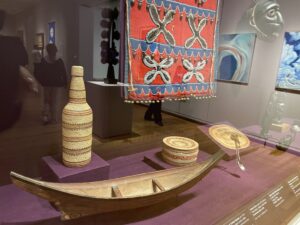
The Internationalism of Objects white artists working with materials like Ivory from Sierra Leone, or silver from Peru both colonial extractive practices
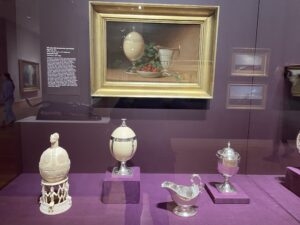
Reimagining Regionalism
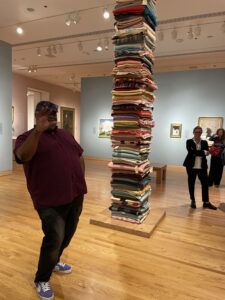
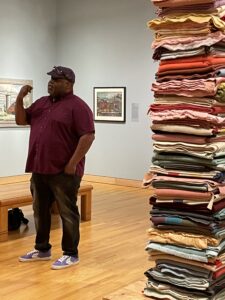
Inye Wokoma, the third consulting artist, worked as a curator here. He excavated works of art buried in storage to curate an entire gallery that “Reimagines Regionalism.” Then he wrote long interpretations with his insightful perspectives.
Relations, 2007. Each blanket has a story.
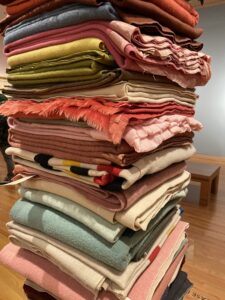
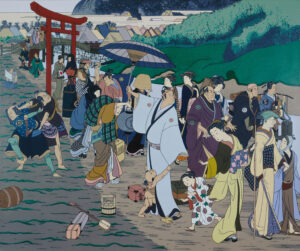
Leading off is Roger Shimomura 1978, Minidoka Series #2: Exodus, 1978 from his first Minidoka series, in the Ukiyo-e style.
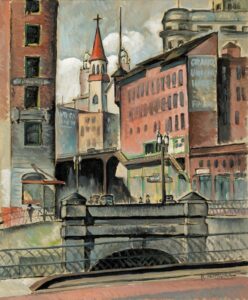
Next to him, the mid-century modernists Kenjiro Nomura and Kamekichi Takata are finally given the prominent place they deserve.
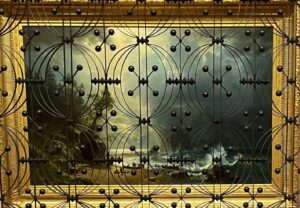
My favorite juxtaposition in Wokoma’s gallery was the overlap of an elevator door of the Chicago Stock Exchange in front of a painting of Puget Sound by Albert Bierstadt. Apparently, Bierstadt never saw the Puget Sound, the painting is entirely fabricated.
Then Wokoma pulls no punches!
“The Indigenous figures along the dramatic shoreline seem inconsequential to the grand possibilities of the land: the subtext for this painting commissioned by a wealthy merchant. . . The elevator screen from the Chicago Stock Exchange (ca. 1893-94) by the “father of skyscrapers” Louis Sullivan is an utterly literal symbol of economic expansion, the overwhelming might of colonialism. Now installed so that visitors can move entirely around it and look through it, the screen offers an opportunity to consider what this gateway was leading to—and what it kept out.”
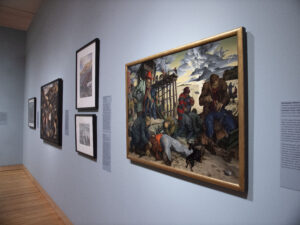
Regionalism Gallery Rudolph Franz
Zallinger
Northwest Salmon Fishermen, 1941
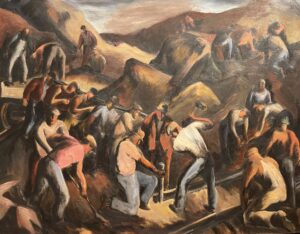
Kenneth Callahan building a logging railroad
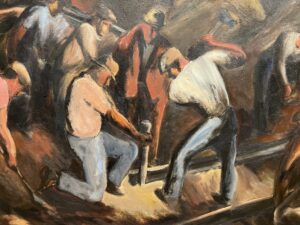
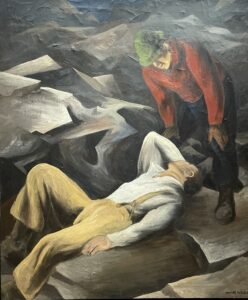
Kenneth Callahan The Accident restoration project
Inye’s selection included several images of w orkers by Kenneth Callahan and other artists of the thirties, rather than the usual glorification of the Western myth of progress.
Ancestors + Descendants
Faces of America
is equally radical, for example it juxtaposes paintings by such as the well known work of Thomas Eakins and John Singleton Copley with paintings by Kehinde Wiley and a talking tintype by Will Wilson of a Lummi violin player
.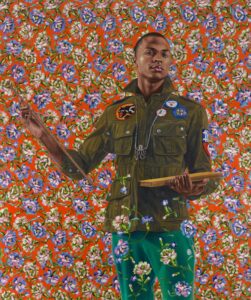
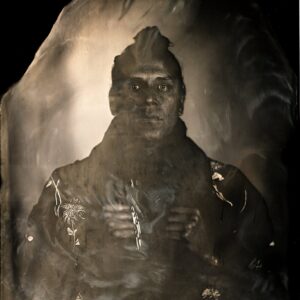
Will Wilson portrait of Nicholas Galanin
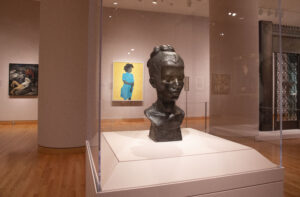
Portrait of Gwen Knight by Augusta Savage
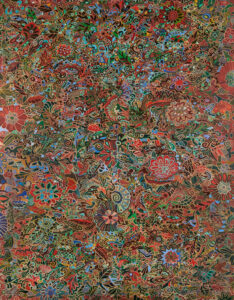
In the last gallery “Ancestors + Descendants/Memory-Keepers” includes the only Latinx artists Alfredo Arreguin, (above) acquired only this year, and Cecilia Alvarez,(below) a gift to the museum in 1992 and never before exhibited.
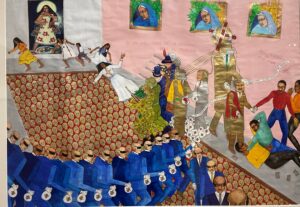
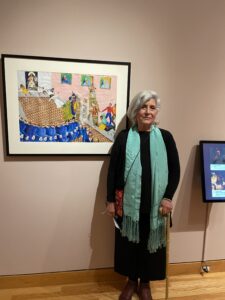
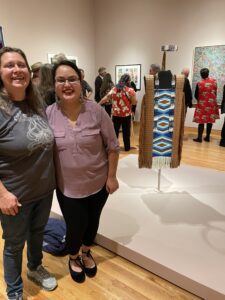
Danielle Morsette Colors of the Salish Sea: Coast Salish Hybrid Tunic Dress,
The grand finale is the extraordinary basket by Suquamish artist Ed Carriere. He recreates weaving techniques from thousands of years ago by working with archeologists to recover fragments from waterlogged sites. As Brotherton states “Carriere’s precise work challenges notions of artistic hierarchy and provides a nuanced view into the brilliance of transforming humble materials into works of memory and power.”
“The Stories We Carry,” entirely rejects traditional myths of the American West such as Manifest Destiny. Instead the stories told here by a diverse cross section of voices, explore questions of conquest and colonialism, as well as exchange and tradition.
~Susan Platt, PhD

